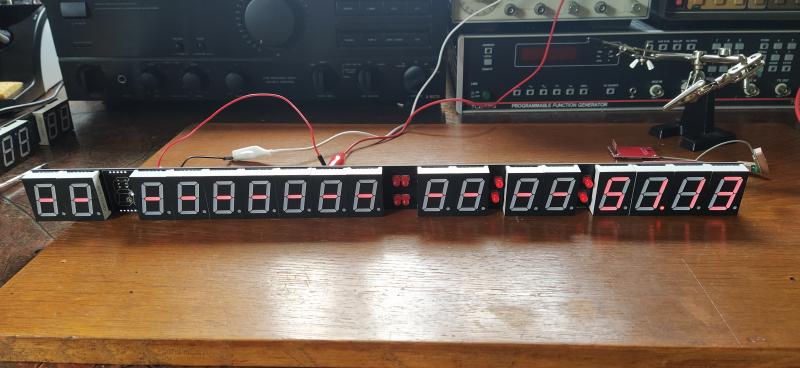

| paulek | Posted: 28 Mar 2021, 12:10 PM |
|---|---|
|
Member Posts: 3 Joined: 28-March 21 |
Hi, I built the precision clock on my own to learn something about board manufacturing and finding and byung all the parts on my own. Now I got a problem. The clock is turning on, all middle segments turn on and the clock counts up until it gets a GPS fix. After it got a fix, the individual 5mm LEDs begin blinking and the rest of the clock, except the last digit, freezes. What might be the problem here? Obviously something is working but then the microcontroller does something strange. kind regards  ------------- |
| [top] | |
| mit | Posted: 29 Mar 2021, 10:44 AM |
|
yeah whatever Admin Posts: 653 Joined: 4-May 16 |
Have you set the fuses on the ATtiny? When it's counting up, is it counting in real-time? That could tell you if the clock speed on the chip is correct or not. Also - a black PCB?? sacrilege! ------------- |
| [top] | |
| paulek | Posted: 29 Mar 2021, 04:23 PM |
|
Member Posts: 3 Joined: 28-March 21 |
I have just flashed the hex file from github and have done nothing else. It's counting up in real-time, yes. The last digit shows tenths and from there upwards it is seconds. Sorry for the black PCB, I got lured by the matt finish. ------------- |
| [top] | |
| mit | Posted: 29 Mar 2021, 04:30 PM |
|
yeah whatever Admin Posts: 653 Joined: 4-May 16 |
If the last digit is showing tenths then it's not realtime. You need to set the fuses to disable the DIV8 bit, either using the makefile (make fuses) or with avrdude:avrdude -p t2313 -B2000 -U lfuse:w:0xe4:m I'm kidding about the colour, it looks good! ------------- |
| [top] | |
| paulek | Posted: 31 Mar 2021, 02:48 PM |
|
Member Posts: 3 Joined: 28-March 21 |
Today, I finally found time to do it and it works now! Thank you for your help and the whole project. ------------- |
| [top] | |
| Xenthera | Posted: 14 Sep 2024, 05:29 PM |
|
Member Posts: 1 Joined: 14-September 24 |
QUOTE (mit)
If the last digit is showing tenths then it's not realtime. You need to set the fuses to disable the DIV8 bit, either using the makefile (make fuses) or with avrdude:avrdude -p t2313 -B2000 -U lfuse:w:0xe4:m Would you be able to put this in the assembly guide as a note for those sourcing their own components? I did the same as this guy and had the same issue until I spent 30 minutes clicking around on your forum trying to find the answer lol ------------- |
| [top] | |
| k0jdd | Posted: 6 Apr 2025, 02:39 AM |
|
Member Posts: 7 Joined: 6-April 25 |
A question arises when comparing the command to reflash the attiny in order to change time zone (from the assembly instructions )avrdude -c USBASP -p t2313 -U flash:w:us_eastern.hex:i and the command to set fuses (listed here) avrdude -p t2313 -B2000 -U lfuse:w:0xe4:m If I am using a usbasp to set the fuses don't I need to tell avrdude that? avrdude -c USBASP -p t2313 -B2000 -U lfuse:w:0xe4:m ------------- |
| [top] | |
| mit | Posted: 6 Apr 2025, 10:16 AM |
|
yeah whatever Admin Posts: 653 Joined: 4-May 16 |
If you are changing the timezone, you do not need to set the fuses. You only need to worry about fuses if you are flashing a new chip. ------------- |
| [top] | |
| k0jdd | Posted: 6 Apr 2025, 01:55 PM |
|
Member Posts: 7 Joined: 6-April 25 |
Apologies, I was not clear. I AM flashing a new chip. (I am building some clocks from locally sourced parts and the Gerbers you so graciously shared via PCBway.) Does my revised command for doing this with a uspasb look correct? avrdude -c USBASP -p t2313 -B2000 -U lfuse:w:0xe4:m ------------- |
| [top] | |
| mit | Posted: 6 Apr 2025, 05:36 PM |
|
yeah whatever Admin Posts: 653 Joined: 4-May 16 |
Ah I see, yes that looks fine. I think there is a config file for avrdude which specifies the default programmer, so if that is set up then you can leave out the -c argument, but it never hurts to put it explicitly. I was apparently inconsistent when I wrote the makefile which has a bunch of the commands: https://github.com/mitxela/PrecisionClockMkII/blob/master/makefile The osccal stuff at the end is for calibrating the internal oscillator, which needs the special hardware I described here, but that usually isn't needed, the majority of chips are fine from the factory. ------------- |
| [top] | |
| k0jdd | Posted: 7 Apr 2025, 01:24 PM |
|
Member Posts: 7 Joined: 6-April 25 |
Worked like a charm. I bad to slow down the clock rate a bit (as suggested by avrdude)MacMini-M2-Pro:avrdude_macOS_64bit k0jdd$ ./bin/avrdude -B 20Khz -c USBASP -p t4313 -U flash:w:london.hex:i Cheers! ------------- |
| [top] | |
Sign in to post a reply.